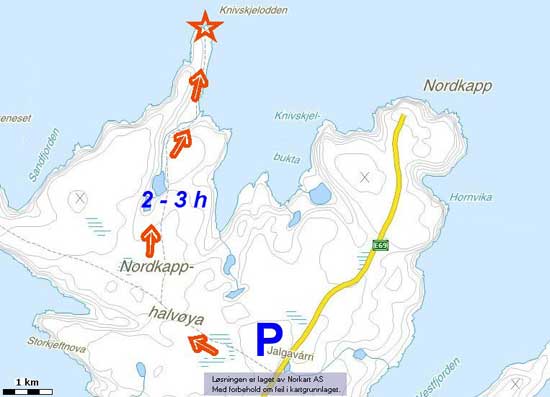Norway on a Shoestring
submitted by "indu"
Learn how to travel the inexpensive way in Norway
Norway is expensive. Compared to other countries it may even seem ridiculously expensive.
What Norway has, though, is incredible nature, incredible scenery and incredible motorcycle roads that should not be missed.
(Additional information can be added in comments below.)
This post is meant to be a guide for all you adventurers who wants to visit this fjord- and mountain-ridden country without the fear of spending all your hard-earned money in a whizz. It's actually quite possible to get by in Norway on - well, if not a shoestring at least on a mid-sized piece of rope. Here are the tips on how to get by. And please, do add to this list if you have additional info.
PS: Don't be afraid of not knowing any Norwegian. Practically all of us are delighted to have a conversation with you in English, although you totally melt us if you learn some phrases like "tusen takk" (thank you) or "får jeg spandere en øl?" (can I buy you a beer?)
PSII: The following are suggestions only. I can not in any way be held liable for any inconvenience or losses due to following any of the advice given. You are, as always, encouraged to do your own research to make sure. Just so you know.
GENERAL INFORMATION
Time
GMT +1 hrs (Summer time from mid-March to mid-October)
Emergency phone numbers
Police: 112
Fire: 110
Ambulance: 113
Major cities
Oslo, capital (south-east)
Trondheim (mid)
Stavanger (oil capital, south-west)
Bergen (west)
Tromsø (Paris of the north - you'll know when you get there... ;-)
Argh! My bike broke down and I can't repair it myself!
Call Norwegian Motorcyclist's Union (NMCU) at +47 9083 7374. They can provide you with info about the nearest workshop for your bike.
Cash or card?
Practically all shops, stores, petrol stations etc accept credit cards. There are three major exeptions: Grocery stores, The Wine & Spirit Monopoly and pharmacies. They only accept cash or debit cards. Visa and Eurocard/Mastercard are the most widely accepted card, but AmEx and Diners are accepted in many places too.
Can I drink the tap water?
Absolutely. The water in Norway is top stuff, even the tap water. Food hygiene in general is very good so you don't have to worry about germs should you choose a salad with your occasional restaurant meal.
I've fallen ill!
If you're an EU citizen, just bring your European Health Insurance Card (EHIC, formerly known as E-111) and you'll have free treatment as any other Norwegian. The health system is pretty good, and it's tax funded so all benefits from the same quality care irrespective of your personal economy.
If you're non-EU or EEC citizen, make sure to have a health insurance before arriving.
You're in any case fully covered should you get injured in a crash, as this is emergency treatment.
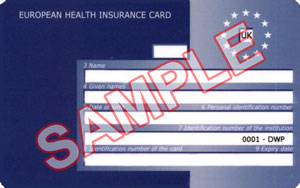
The EHIC is the size of a credit card and gives its bearer (EU/EEC citizen) free hospital treatment in Norway as well as the rest of EU Europe.
I'm in a restaurant/bar and want to have a cig
No can do. Norway enjoys a totally smoke-free environment in all public indoor places, including restaurants, bars, shopping malls, sports arenas, etcetera. Even some of the cabins you rent at camping sites may have an indoor smoking ban.
How about road toll?
Motorcycles are generally exempt from road toll, the exception being where a bridge or stretch of tunnel has substituted a ferry or other means of transport where you'd pay anyway.
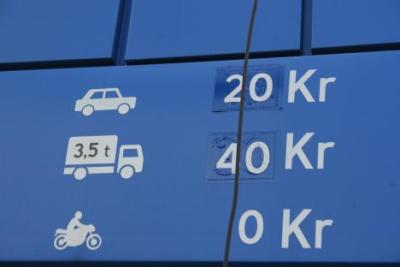
Bikes are, with a few exeptions, exempt from road toll in Norway.
I have X days at my disposal - can I ride from south to north and back again in that time?
Remember: Norway is a very long country. The roads tends to be bendy especially along our magnificent coastline and a general low speed limit sets the scene for a slower pace than you may be used to. Norway is more than 2.500 kilometers from the southernmost to the northernmost point. If time is a concern, you can always race up to Nordkapp through Sweden - extremely boring, but fast (allow for 2-3 days), then take the real journey along the coast back south.
Is it too late to go to Nordkapp in September?
Not necessarily. Temperatures can vary heavily, from around 0 centigrades and up. You may find yourself in a snow squall, but the snow will usually not stay on the road. Temperatures at night may go well below freezing. Or you may encounter the Arctic equivalent of an Indian summer, with surprisingly high temperatures. Mountain passes may be cold, though, so prepare for long hauls in the wet and with low temperatures. Also, be aware that many camping sites have closed for the season by September, but some are open all year. Check accomodation under "Shoestring tips" further down this article.
How is the driving culture? Can I filter with my bike?
The traffic in general is slow, usually polite and not crowded at all, except in the rush hours in the larger cities. But it's probably nothing near what you're used to if being, say, from Paris, London or your average Italian town. Norway has the lowest traffic accident rate in Europe, including motorcycles. So the slow speed limits may have some advantages after all. And yes, you may filter. And you can use lanes designated for bus and taxi as long as you ride a two wheeled motorcycle. Sidecars are not allowed in the greenlane anymore. When riding along the smaller roads you may experience long stretches meeting no-one else except your occasional sheep. Oh, and do keep an outlook for any wildlife straying over the road - the elk/moose in particular. Slamming into 400 kgs + of meat even at the slow Norwegian speed limits is not something you want to do. Up north reindeer tend to pay no attention at all and just walk all over the road just for fun, it seems.
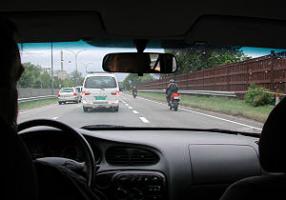
You can filter with your bike and even use the lanes designate for bus/taxi.
Jeez... That's a lot of tunnels. And some of them are pretty dark...
Norway's pretty mountainous and needs some tunnels here and there to speed up the transit between the major cities. Some of those tunnels are pretty old, though. Safe, but old. And some are poorly lit. The trick is to close one of your eyes a few seconds before entering the tunnel. When inside, open you eye again. It should have adjusted a bit to the darkness thus making it easier to see. Or, if tunnels is not your thing you can always go around most of them. Check your map.
Where is the best place to get a tan?
If you're afraid of some bad weather, you may not want to have Norway on your shortlist. Sometimes the weather beats anything in Europe for weeks and weeks. At other times it keeps raining and the temperature is really low for months. To check the weather at your destination in Norway, visit this online weather service. The best time to visit Norway weather-wise is generally speaking mid-May to mid-September, the warmest period being July and August. Bring your rain gear as well as you bathing suit. Be prepared for everything.
Where should I go? What's to avoid?
Regarding fine motorcycle roads in Norway, you basically can't go too wrong whatever you choose. The area around the capital Oslo is dull, and this is where you find the most boring stretches of highway. But apart from that, you can go inland in the mountains and have a great trip, or you can go up the west coast having a ball for your eyes and on your bike. Obviously, even in Norway there are tourist traps. The North Cape plateau is probably the worst of them all if you ask me, but that's because they make you pay to go into an area which a number of us Norwegians consider being common land, thus being subject to the freedom to roam right. Besides, the plateau is not the northernmost point. Actually, it is Knivskjelodden, being 1600 metres farther north - and free of charge. Be prepared for a walk of some 7 kilometres to get there, but hey - how often do you visit the Cape?
To help you in the planning process, The Official Travel Guide to Norway can at least give you some ideas where to find e.g. the Top Ten Nature Attractions in Norway.
Knivskjelodden is actually the northernmost point in Europe mainland - not Nordkapp. Besides, Knivskjelodden is for free.
I'd like to ride on some gravel roads - is it possible?
Very possible, and very enjoyable too. Here's a map of Norway.
It's in Norwegian, but pretty self explanatory. From scale 1:100 000 you can see what kind of surface the roads have. On the file symbols to the left, choose "Vegdekke" (Road Surface). Then choose "Vegdekke_massetype (Fra 1: 100 000)" (Road Surface_type (from 1:100 000))
Refresh the map with "Vis kart" (Show map)
You typically want to find the roads called "Grus" ("Gravel") and/or "Skogsbilveg" (Forestry road/trails)
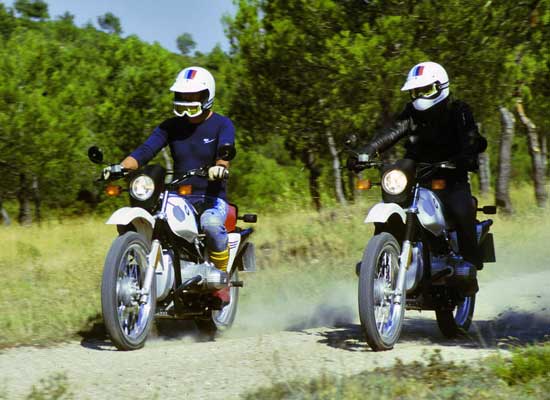
Gravel riding is great fun! Photo: MC24.no
Which maps do you recommend?
Cappelen have the best maps of Norway. Scale should be at least 1:350 000 to be able to see also the smaller, most motorcycle-friendly roads. Cappelen's maps are easy to read and very updated. They're a bit pricey but they are worth every krone. You can find them at any bookstore in Norway.
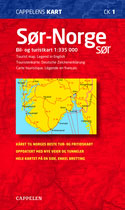
Cappelen's road maps are the best, in my opinion.
Tip from Bjørn Storm Lillehaug (NOR): Cappelen issues a special road map for motorcyclists, plainly called "MC Map Norway" (pic below). It consists of eight loose but laminated pages made to fit the map compartment on your tank bag. The scale is 1:1.1 mill, but it gives you a good overview of the good M/C roads - and which are not. Price is NOK 199,-.
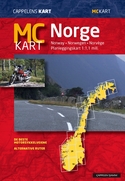
MC Norge Map
What's up with the Krone anyway?
The Krone has been pretty strong from time to time, taking larger chunks of any foreign traveller's budget. This is a situation that fluctuates, especially these days, and it may have changed in a year's time for all we know. Take an extra night wildcamping to compensate for any poor exchange rates.
How do I get there?
Depending on where you leave from, you have several options to get here: Coming from continental Europe (Germany) you can ride through Denmark and Sweden, crossing into Norway at Svinesund. You can also use a ferry from Denmark (Copenhagen, Hirtshals, Fredrikshavn, Hanstholm) or Germany (Kiel). There used to be a ferry service from the UK, but it shut down as of September 2008. There is, however, a possibility to use the DFDS Tor Line freighter. It accepts passengers and bikes on certain conditions. The ferry leaves from Immingham to Kristiansand and Brevik. Also check out Immingham-Gothenburg or Tilbury-Gothenburg, as Gothenburg is only some 3 hrs from the Norwegian border. Some also choose to take the ferry Kiel-Gothenburg and ride on to Norway from there. Check out Stena Line or Color Line. The ferries have adequate straps to tie down your bike with during the crossing. Remember to buy your tax-free goods while on board!
Where can I connect my wireless laptop to the internet for a fair price?
You can actually do that for free in many places. At some Statoil petrol stations you can connect for free on your wireless. Just sit on a bench near the station and you get crisp, clear signals. Some hotels, hostels, libraries, cafes etc may have free or cheap online connections services. If you didn't bring your laptop, seek out e.g. hotels and libraries to get hold of a PC to lend or rent for a while. Major cities like Trondheim have a lot of "hotspots" too.
I'd like to visit a motorcycle rally while in Norway
That's actually quite smart because you meet other motorcyclists and it is a place where food and beer is usually sold at very affordable prices. Here you'll find a list of motorcycle rallies in Norway. It's in Norwegian, but use your preferred translation tool to sort that out. Or send me a PM and I'll translate it for you.
Are there any dangerous animals in Norway? Polar bears and stuff?
The only place you'll encounter polar bears on Norwegian soil is on Svalbard, an isolated group of islands near the North Pole. You don't want to ride your bike there anyway. In mainland Norway, I have never encountered a bear, wolf, lynx or any other large predator in my 40 years of living out- and indoors in the south and north of Norway. There have been extremely rare sightings of bears strolling over the border from Sweden but I guess they too where shocked by the price levels here so they went back. In other words: Don't worry.
Mosquitos, on the other hand, may be an annoyance especially in the northern parts of Norway. Bring your repellant. Tropical versions are the ones to go for. Or buy repellant at the local pharmacies. They know what it takes to get rid of them mozzies.
Ticks have become a recent annoyance among forest dwellers in Norway. They are especially evident in the southern parts. Ticks are know to transfer Borelliosis to some of their victims. These are fortunately rare happenings, but can be a very serious condition. Make sure you don't run around in the forests of southern Norway without proper protection - repellant or covering clothing. Check yourselves for ticks once in a while to make sure. If red rings appear around a bite, seek medical treatment immediately, as this is a sure sign of Borelliosis.
I love to fish - do I need a license for that as a foreigner in Norway?
To fish in lakes and rivers you will need a fishing license. Usually you can get them from any nearby petrol station, kiosk, store or camping site. Special rules govern fishing for salmon and sea trout, where you also need a national government issued license. Fishing in sea water is for free, though, and requires no license. The fresh Arctic seawater provides you with good quality fish even near the shores. Unlike e.g. the Britts, Norwegians fish to eat the catch - not release it. Fishing is a good way to have some very cheap, tasty dinners. Please make sure that you use clean fishing equipment to avoid spreading diseases between the lakes and rivers in Norway.
SHOESTRING TIPS
Expensive:
Tobacco, alcohol - especially in restaurants.
How to get by:
Buy your carton of cigs/tobacco and your whisky aboard the boat from Sweden/Denmark/Germany/UK (regular UK ferry link ended Sept 2008 - see "How do I get there" above) tax & duty free. Norway is non-EU which means you can import such things without taxes.
Limitations: - 200 cigarettes OR 250 grams of other tobacco products
AND
- 1 litre of spirit (22-60% vol) AND 1.5 litre of wine (2.5-22% vol) OR 3 litres of wine (2.5-22% vol)
AND
- 2 litres of beer (2.5-4.7% vol) (You can import 5 litres of beer if you choose not to import wine/spirit)
Expensive:
Hotel accommodation
How to get by:
Everyone in Norway enjoys the right of access to and passage through uncultivated land in the countryside (read more about this right here.) If you bring your own tent, you can put it up pretty much wherever you like. Please stay out of people's gardens and at least 150 m from the nearest house/cottage.
Campgrounds are widely available, safe and are in general a nice place to put up your tent as you often have certain service facilities like laundromats etc available. To find your campground when planning, visit this site.
You are advised to buy the Camping Card (valid throughout Scandinavia) for cheaper stays - and it is compulsory at some camping sites. It can be bought at practically any camping site in Scandinavia, or you can order it online.
Hytter, or cabins are very popular and are found at most camping sites. Not so expensive, and far drier than a tent when it's raining... You have 11 000 "hytter" to choose from all over Norway, so they are in abundance. But if you want a cabin, check in early or phone your chosen camping site in advance for booking as they are popular to rent. Prices range from 20-30 euros for simple ones to 80-100 euros, sometimes even more, for spacious luxury cabins.
Hostels are also safe, popular and inexpensive. I tend to use them a lot myself. Book in advance if possible, as they too are popular among travellers. Prices usually range from 30-40 euros (dorms) to more than 100 euro for your own "all-inclusive" room or cabin.
You are advised to become a member of Hostelling International as this gives you cheaper rooms and sometimes priority check-in.
And, of course, you have your fellows at the Norway HU Community at a keyboards reach. I for one gladly accommodate fellow travellers if I'm at home. I also have a garage where you can do some basic (and sometimes not-so-basic) maintenance. I live a 25 minute ride south of Oslo.
You MAY find cheap hotels in the summer as the activity tends to slow down in the business accomodation area, but aim for smaller, not-so-fancy hotels and show up at the front desk to get the bargain. Find your hotel e.g. at Hotels.com.
Expensive:
Restaurant dinners
How to get by:
The answer is obvious: Bring canned food from your less expensive home country. Or buy your food at the local supermarket and prepare it yourself. The least expensive supermarkets are the ones designated Rema 1000, Rimi, Kiwi and Prix, just to mention a few. They have a basic assortment of groceries - not anything fancy, just what you need. To get the more fancy stuff, aim for supermarkets at shopping malls, where it's more expensive but the assortment is far better. A good tip, if you're in the larger cities like Oslo, Trondheim, Bergen, Stavanger, Tromsø and even in some smaller towns, is to buy from stores usually run by imigrant Pakistani. They have good quality foodstuff to a far better price than any of the Rema's and Rimi's.
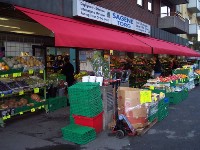
Small shops run by imigrants usually have good quality foodstuff to a great price.
McDonald's and Burger Kings are to be found too. Cheapish, and you know what you get...
Most places in Norway have their local Chinese restaurant. Some larger towns even have Thai or other Asian restaurants. And the largest towns and cities have Arab cuisine restaurants. All of them usually have great food for a small price. Try them if you need a break from your home-but-away cooking.
Expensive:
Alcohol - and my tax free whisky is emptied!
How to get by:
Wow, now you've done it... But there are some fairly cheap hopes in sight. Beer can be found at supermarkets at 1.2 euros pr 1/2 litre, which is really cheap in Norway. If you want spirits or wine, you must visit the Norwegian Wine and Spirits Monopoly, which is not a board game with a twist but a state controlled and run chain of wine and spirit outlets spread all over Norway. The upside is a great selection of wine and booze. The downside is the price. You need to find outlets bearing this sign:

They are usually found at shopping malls and other places where people tend to gather to do shopping. Whisky prices, for example, range from 15 euros per 70 cl bottle (but I'd only advice drinking that offer if you are really in need...) up to hundreds and hundreds of euros. Prices are based on policy rather than market mechanisms, but we've grown used to it. If you're near the Swedish border, pop over and buy your stuff at the Swedish equivalent "Systembolaget" like any other price-conscious Norwegian do. Half the price, at least.
Expensive:
Tobacco - and my carton of Marlboro is emptied!
How to get by:
This is a great opportunity to quit smoking. It'll save your wallet and - more important - your health. But if you insist keeping on ruining your lungs on smoking tobacco, it comes with a price in Norway. A pack of 20 cigarettes is usually around 10 euros even at the cheapest convenience stores in Norway. If you're near the border to Sweden, pop over and stand in line with the other nicotine junkies to get hold of your fix at an average rate of just over 2 euros pr pack.
Expensive:
Speeding and getting caught while doing it
How to get by:
All you've read about speed limit enforcement in Norway is true. If you get caught speeding e.g 21-25 km/h over the limit in areas where the limit is 60 km/h or lower, you'll see a fine of close to 900 euros. 31-35 km/h over in areas where the limit is 70 km/h or higher will cost you close to 1000 euros. You will lose your license on the spot if you get caught in even higher speeds.
The good thing is that speed controls are usually held along highways and in more densly populated areas. You typically want to ride the smaller roads where there are fewer cars and fewer police patrols. On these roads you don't want to speed anyway because the surroundings are too magnificent to be missed because you rode to fast. NB: Gatsos, or speed cameras, do not recognize bikes so you're safe from them.
Expensive:
Drunk driving
How to get by:
This is the one where you don't get by. There is a zero tolerance for drunk driving in Norway. You drink and drive, you get arrested. You will see time in jail (pending a bilateral process involving your country's embassy) and extremely heavy fines. Norwegians in general loathe drunk drivers and will report you if they suspect you doing it. Not because they are snitches in general but because drunk driving too often have ended up in a meaningless loss of innocent lives inflicted by the drunk driver. Even if you are convinced that a couple of beers doesn't affect you because it never has in your home country: Do NOT drink and drive while in Norway. I think you've got the message.
Expensive:
Gasoline/fuel/petrol
How to get by:
Fuel prices are generally speaking a bit more expensive in Norway than in the rest of Europe. But not much. If you have e.g a Shell card, you might get some rebate on the pump price. Use international oil companies' stations (e.g. Exxon (Esso in Norway), Texaco (HydroTexaco in Norway), Shell) if you have their cards. If not, any station will do.
Expensive:
A cup of coffee - jeez, they're charging like 3 Euros just for a cup at the cafeteria!
How to get by:
Go to your nearest Statoil petrol station. Buy the Breakfast Club coffee cup. It cost NOK 99 (approx. 12 Euros), but you can drink all the coffee you like at any Statoil station for the rest of the year. And you get a nice cup to keep.
BMW made their commercial video (under) of the R1200RT in Norway.
It has turned into pure Norway Porno. Promo. I meant promo.
Oh, and just to have mentioned it: I tipped off the official tourist board of Norway's web page www.visitnorway.com about these budget tips, thinking maybe others may want the info. They have made their own page (even using some of my words - which I don't mind at all) but be aware that these people are not riders and for-profit. But it may be worth having a look nevertheless.
Member login
Announcements
Thinking about traveling? Not sure about the whole thing? Watch the HU Achievable Dream Video Trailers and then get ALL the information you need to get inspired and learn how to travel anywhere in the world!
Have YOU ever wondered who has ridden around the world? We did too - and now here's the list of Circumnavigators!
Check it out now, and add your information if we didn't find you.
Are you an Overland Adventure Traveller?
Does the smell of spices wafting through the air make you think of Zanzibar, a cacophony of honking horns is Cairo, or a swirl of brilliantly patterned clothing Guatemala? Then this is the site for you!
Hosted by Grant and Susan Johnson, RTW 1987-1998
Next HU Events

Be sure to join us for this huge milestone!
ALL Dates subject to change.
2025 Confirmed Events:
Virginia: April 24-27
Queensland is back! May 2-5
Germany Summer: May 29-June 1
Ecuador June 13-15
Bulgaria Mini: June 27-29
CanWest: July 10-13
Switzerland: Aug 14-17
Romania: Aug 22-24
Austria: Sept. 11-14
California: September 18-21
France: September 19-21
New York: October 9-12 ![]()
Germany Autumn: Oct 30-Nov 2
2026 Confirmed Dates:
(get your holidays booked!)
Virginia: April 23-26
Queensland: May 1-4
CanWest: July 9-12
Add yourself to the Updates List for each event!
Questions about an event? Ask here
Books

All the best travel books and videos listed and often reviewed on HU's famous Books page. Check it out and get great travel books from all over the world.
NOTE: As an Amazon Affiliate we earn from qualifying purchases - thanks for your help supporting HU when you start from an HU Amazon link!














